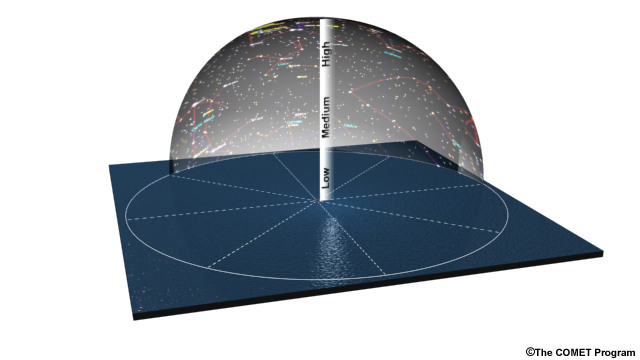Determining Sky Cover
To determine the sky cover, first we want to divide the sky in half, and then into quarters, and then into eighths. Now, mentally push the low clouds to one side of the sky, and determine how many eighths they cover. In this case, the low clouds cover 2/8ths. Next, move the mid clouds. They cover 1/8th. Now move the high clouds. They cover another 1/8th. We need to add the low clouds' 2/8ths to the 1/8th of the mid and 1/8th of the high clouds. So, our total sky cover is 4/8ths. AG2 Ferguson describes the process of determining sky cover.
AG2 Ferguson: "Next you need to determine how much cloud cover you have. By determining cloud cover, you have to decide how many octas of the sky is covered. Octas are eighths. First you want to break the sky in half, and then into quarters, and then into eighths. Then you want to start with low clouds – you want to push all low clouds to one side of the sky, and determine how many eighths coverage you have. Today, I would say we have a few clouds at two thousand feet, which would be two-eighths coverage. Moving up, we're going to go to mid-clouds. Today there is no mid-cloud, so we're going to move to high cloud. For high cloud, we have cirrus, and I would say that we have one-eighths coverage of cirrus. Sky coverage is cumulative, so you have to add the one-eighth to the two-eighths coverage we had for the low cloud earlier. So, we have a few clouds at twenty thousand feet, and total sky coverage of three-eighths."
Sky cover for each layer can be determined based on the degrees of the celestial sphere covered by the cloud. The values are then reported as whole numbers corresponding to the eighths of the sky covered, i.e., "6" for 6/8, "0" for clear, and "1" for 1/8 or for a trace of cloud. The total sky cover entry cannot exceed "8".

At night, the sky is considered to be clear if stars are plainly visible in all sections and no cloud or obscuration is observed. Reflection or sky glow from city or other lights can be useful for estimating the amount of low cloud layers. Night vision goggles (NVGs) can also be used to differentiate cloud layers and estimate nighttime cloud amounts.
| Reportable Contraction | Meaning | Summation Amount of Layer |
|---|---|---|
| SKC or CLR | Clear | 0 |
| FEW | Few | 1/8 - 2/8 |
| SCT | Scattered | 3/8 - 4/8 |
| BKN | Broken | 5/8 - 7/8 |
| OVC | OVC | 8/8 |
| VV | Vertical Visibility | 8/8 |
The summation amount of cloud cover can be reported as a contraction summarized in Table II-3-10 (above) from your observer's manual.
Any layer amount less than 1/8 is reported as FEW.
Note that automated stations should report no more than three layers and should use CLR when no layers at or below 12,000 feet are reported. Manual observers should report no more than six layers and use SKC when no layers or other obstructions are reported.

